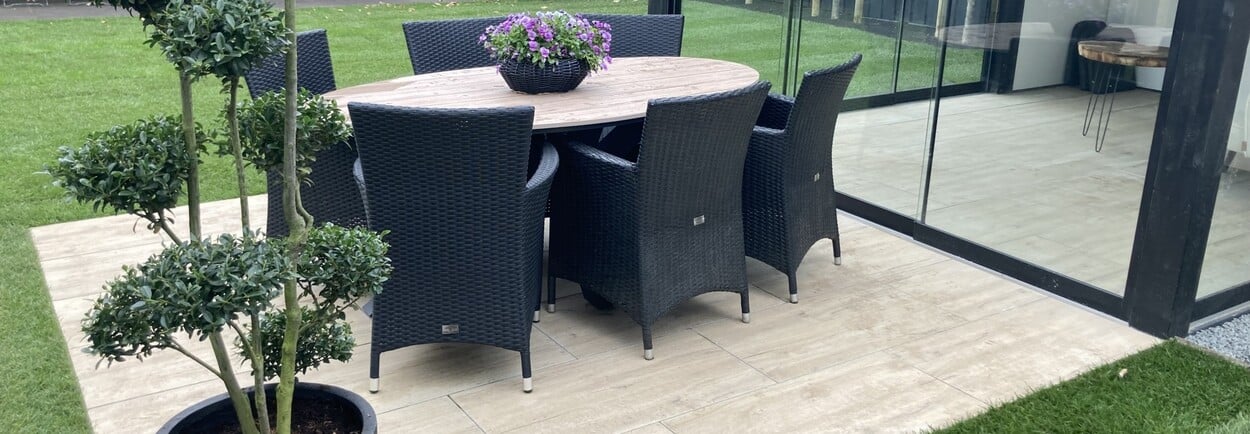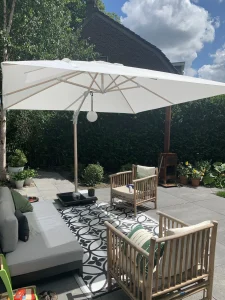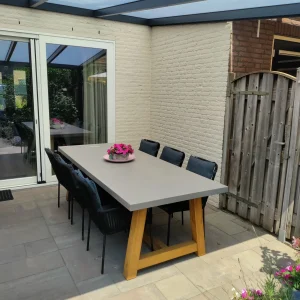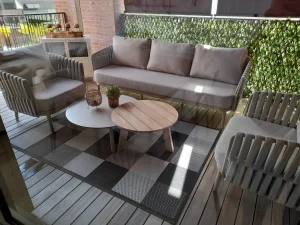Winter warmth and spring freshness
The rhythm of the seasons has a significant impact on the way we experience and use our outdoor space. In this chapter, we explore the dynamics of seasonal change and how it influences garden furniture trends. Whether it’s the coziness of winter or the fresh renewal of spring, garden furniture trends evolve to meet the needs of each season.
Seasonal changes go hand in hand with changes in our lifestyle and daily activities. In winter we strive for warmth and comfort, while spring inspires us to seek out fresh air and breathe new life into our outdoor spaces. These natural shifts form the basis for the trends we see in garden furniture .
The first part of the blog delves deeper into the winter influences. During these cold months, people strive for coziness and warmth in their gardens. We explore garden furniture that is specifically designed to provide comfort in the cold. Think luxurious cushions, blankets, and fire pits that create an inviting atmosphere, even when the temperatures drop.
After winter, we are making the transition to spring. The second part of this chapter takes a look at spring trends and how they translate to garden furniture. Fresh colours, light materials and innovative designs are explored as a response to the renewed energy that spring brings.
The trends we discuss in this chapter will serve as the foundation for the rest of the blog series. By understanding the seasonal changes and embracing the needs of each season, we can select the perfect garden furniture that is both functional and stylish. In the following chapters, we will delve deeper into specific aspects of these garden furniture trends, ranging from winter warmth to spring renewal.
Comfortable Garden Furniture for Cold Days
Amidst the winter chill, we strive to transform our outdoor spaces into warm havens where comfort and coziness come together. This chapter takes a detailed look at garden furniture that is specifically designed to embrace this winter warmth.
Winter is all about creating a pleasant atmosphere, even outdoors. We are exploring garden furniture that contributes to this, such as lounge sets with thick cushions that provide a cozy place to sit, even on the coldest days. Think of comfortable armchairs and sofas with integrated heating options to brave the cold.
Blankets and throws are becoming not only functional but also decorative, and we explore how these accessories can contribute to the overall winter aesthetic of the outdoor space. The use of fire pits and patio heaters not only adds warmth, but also creates a cozy ambiance that invites relaxation.
In addition, we focus on materials that can withstand winter weather without compromising on style. We explore weatherproof fabrics and robust constructions that stand the test of time, even in harsh weather conditions. This chapter offers insight into the versatile world of winter garden furniture and how it maximizes comfort in the garden, even when the thermometer drops.
The emphasis is on understanding the needs of outdoor enthusiasts during the winter, and selecting garden furniture that is not only functional but also contributes to a warm, inviting atmosphere. This is a crucial aspect of enjoying the outdoor space during all seasons, including winter. In the following chapters we will focus on spring renewal and adapting garden furniture to the upcoming season.
Garden furniture for a fresh start
After the winter warmth, we now turn our attention to the invigorating renewal of spring. This chapter explores the exciting world of garden furniture trends that perfectly match the freshness and vitality of the new season.
As nature awakens from its winter slumber, we want to transform our outdoor space with garden furniture that reflects this vibrancy. Fresh colours such as soft green, light blue and sunny yellow dominate the spring trends. We explore how these colours are integrated into garden furniture designs, creating an inviting and energetic atmosphere.
Light and airy materials, such as bamboo and lightweight metal, are introduced as a way to bring spring into our outdoor spaces. Comfortable seating areas with cushions in floral motifs contribute to a cheerful and warm look. In addition, we look at how innovative designs, such as modular furniture and multifunctional items, increase versatility, which perfectly matches the dynamic nature of spring.
Storage for garden cushions and accessories is also examined, as a tidy outdoor space contributes to a sense of renewal. The chapter provides insight into how these practical aspects can be combined with aesthetically pleasing designs.
In short, this chapter highlights the transition from winter to spring by focusing on garden furniture that allows for a fresh start. By embracing the colours, materials and designs of the spring trends, the outdoor space becomes an inviting oasis in which the early beauty of the season comes into its own. In the following chapters, we will delve deeper into the aesthetics and sustainability of garden furniture, and how it can contribute to a stylish and functional outdoor environment.
Aesthetics and Sustainability
In the quest for garden furniture that is both stylish and winter-proof, we delve deeper into the world of aesthetics and sustainability. This chapter explores how we are able to enhance outdoor spaces with garden furniture that is not only visually appealing but also able to withstand the challenges of winter.
The aesthetics of garden furniture are influenced by a variety of factors, including colour palettes, designs and materials. We look at stylish trends that remain relevant all year round, with a particular focus on how these aesthetics can be adapted to the winter environment. Think timeless colours, such as deep earth tones and winter white, which add a sophisticated feel to the outdoor space.
Sustainability is key in selecting garden furniture that can withstand winter conditions. We research materials such as teak, aluminium and weatherproof plastics that are not only durable but also require little maintenance. The combination of aesthetics and durability ensures that garden furniture not only looks good but also withstands the elements.
In addition, we explore innovative designs that combine functionality with aesthetic value. Think of clever storage integrated into furniture or adaptable designs that fit different style preferences. This chapter offers readers insight into how aesthetics and sustainability can go hand in hand, making the outdoor space an extension of the residents’ personal style.
In short, this chapter highlights the essential role of aesthetics and durability when choosing winter-proof garden furniture. It offers inspiration and practical tips for creating an outdoor environment that is not only beautiful to look at, but also able to withstand the challenges of winter. In the following chapters, we will delve deeper into the spring season, focusing on renewal and maintenance of garden furniture.
Tips for a Garden Furniture Makeover
Now that winter has passed and the fresh breeze of spring is approaching, it is time to breathe new life into our outdoor space. This chapter is dedicated to creative tips and suggestions for a refreshing garden furniture makeover, making the outdoor environment perfectly suited to the upcoming season.
One of the first steps in this renewal is to rethink colour palettes. We explore ways to incorporate the fresh spring aesthetic into the outdoor space through new cushions, parasols or even a lick of paint on existing furniture. The chapter offers suggestions for colour schemes that will suit the vibrant and inviting atmosphere of spring.
In addition, we look at simple DIY projects that can transform your outdoor space. From refurbishing older furniture to adding small decorative accents, these tips offer readers practical ways to breathe new life into their outdoor furniture without a big investment.
The chapter also discusses the importance of garden accessories, such as planters, lighting and outdoor rugs, in renewing the overall look of the outdoor space. These small details can have a big impact and create a harmonious whole.
In addition, multifunctional furniture pieces are discussed, which allow the outdoor space to be used more efficiently. For example, folding tables or modular lounge sets that can be adapted to different occasions and space requirements.
This chapter acts as a guide for readers looking to transform and renew their outdoor space for the coming spring. With practical tips and creative ideas, spring renovation becomes an achievable and exciting task, making the outdoor space an inviting place to enjoy the first rays of sunshine of the season. In the following chapters, we will delve deeper into the importance of stylish garden furniture and how to maintain it throughout the year.
Extending the Lifespan of Garden Furniture
As we wrap up this blog series, we focus on the crucial aspect of seasonal maintenance, which is essential to maximizing the lifespan of your garden furniture. Whether it’s winter, spring, summer or fall, proper maintenance is key to maintaining the beauty and functionality of your outdoor furniture throughout the year.
We begin with practical tips for winterizing patio furniture. From storing cushions and accessories to protecting metal parts from corrosion, these steps will help readers protect their furniture from the elements during the cold months. The chapter also emphasizes the importance of covers and storage space to protect furniture from extreme weather.
After the winter season, it’s time for a spring clean. We’ll discuss deep cleaning methods for various materials, including wood, metal, and plastic. This includes removing stains, polishing surfaces, and addressing any damage that may have occurred over the winter. By following these steps, readers can make their outdoor furniture shine in the spring sunshine.
The chapter continues with suggestions for regular maintenance throughout the summer and fall. These include simple but effective methods for maintaining the shine of outdoor furniture, such as regular cleaning, applying protective coatings, and inspecting moving parts.
In closing, we emphasize that maintaining garden furniture not only extends its lifespan, but also helps maintain its aesthetics and functionality. By taking these simple but effective steps, readers can enjoy their outdoor space all year round.
This blog series offers a comprehensive insight into the world of garden furniture trends, ranging from winter warmth to spring renewal and the importance of sustainability. With the right knowledge and practical tips, readers can transform their outdoor space into a comfortable and stylish oasis, no matter the season. Enjoy every moment in your garden !











